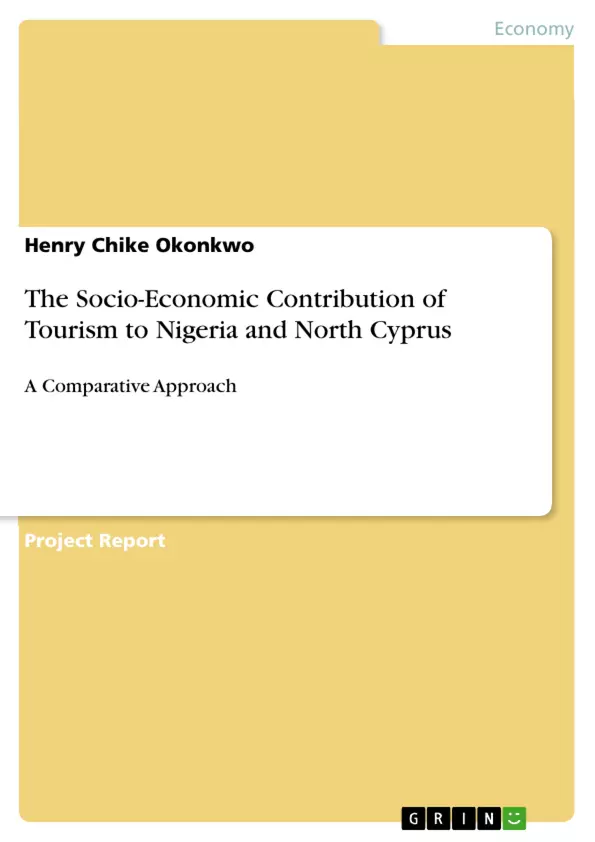This research project is however more in tune with the essence of tourism to developed and developing economies of the world. It seeks to particularly examine the subject matter of tourism and its socio-economic contributions to Nigeria and the small Island of North Cyprus.
Topical issues on the effect of tourism on the GDP, employment, foreign exchange earnings, investment, regional impacts, tourism contribution to taxation, tourism impact on other industries/ sectors are also delved into.
Furthermore, this paper also considers discuss on the relative importance of domestic tourism and international tourism to Nigeria and North Cyprus, and the areas of strength and opportunities, weaknesses and threats as affecting tourism potentials and development in both countries.
The theoretical framework for this paper is premised on the theoretical ideology of functionalism. Its research methodology is founded on the social survey method for a research design; data were collected from respondents both online and offline with the aid of semi - structured questionnaires.
Data collected from respondents are presented, interpreted and analyzed, with further discussions carried out on the finding, sequel to a conclusion and recommendations following. For the sake of emphasis, we find that corruption is largely blamed to be responsible for infrastructural decay in Nigeria. The Northern Cyprus and the Nigerian respondents’ in this study both assets to tourism benefits such as employment creation. The citizens of both countries share a similar propensity to travel outside the shores of their own countries and that tourism to both countries can be immense.
Table of Contents
- CHAPTER 1: INTRODUCTION
- 1.1 BACKGROUND OF THE STUDY
- 1.2 STATEMENT OF THE RESEARCH PROBLEM
- 1.3 RESEARCH QUESTIONS
- 1.4 RESEARCH OBJECTIVES
- 1.5 SIGNIFICANCE OF THE STUDY
- 1.6 SCOPE OF STUDY
- CHAPTER 2: LITERATURE REVIEW
- 2.1 INTRODUCTION
- 2.2 TOURISM CONTRIBUTION TO GDP IN NIGERIA AND NORTH CYPRUS
- 2.3 TOURISM CONTRIBUTION TO EMPLOYMENT
- 2.4 TOURISM CONTRIBUTION TO FOREIGN EXCHANGE EARNINGS
- 2.5 INVESTMENT AND REGIONAL IMPACT OF TOURISM
- 2.6 TOURISM CONTRIBUTION TO TAXATION
- 2.7 TOURISM's IMPACT ON OTHER INDUSTRIES
- 2.8 ECONOMIC IMPORTANCE OF DOMESTIC AND INTERNATIONAL TOURISM
- 2.9 AREAS OF STRENGTH AND OPPORTUNITIES OF THE TOURISM SECTOR
- 2.10 AREAS OF WEAKNESSES AND THREATS OF THE TOURISM SECTOR
- 2.11 THEORETICAL FRAMEWORK
- CHAPTER 3: RESEARCH METHODOLOGY
- 3.1 INTRODUCTION
- 3.2 POPULATION AND SAMPLING
- 3.3 RESEARCH DESIGN
- 3.4 METHODS OF DATA COLLECTION
- 3. 5 METHOD OF DATA ANALYSIS
- CHAPTER 4: DATA PRESENTATION, INTERPRETATION AND ANALYSIS
- 4.1 INTRODUCTION
- 4.2 SOCIODEMOGRAPHIC CHARACTERISTICS OF NIGERIAN RESPONDENTS
- 4.2.1. Redeeming Nigeria's image in order to attract an increased tourist arrival rate
- 4.2.2 The patronage of Nigeria's local tourism industry by Nigerians and the increase of her GDP as contribution from the tourism sector
- 4.3 SOCIO-DEMOGRAPHIC CHARACTERISTICS OF NORTH CYPRUS' RESPONDENTS
- 4.3.1 Overcoming political obstacles, economic isolation, institutional governance and personalized political structures
- 4.4 DISCUSSION OF FINDINGS
Objectives and Key Themes
This research project examines the socio-economic contributions of tourism to Nigeria and North Cyprus, focusing on the impact of tourism on GDP, employment, foreign exchange earnings, investment, regional impacts, tourism contribution to taxation, and tourism's impact on other industries.- The role of tourism in driving economic growth in developing and developed countries
- The impact of tourism on employment and foreign exchange earnings
- The challenges and opportunities for tourism development in Nigeria and North Cyprus
- The importance of domestic and international tourism in both countries
- The role of functionalism as a theoretical framework for understanding tourism's contribution to socio-economic development
Chapter Summaries
- Chapter 1: Introduction: This chapter introduces the research topic and provides background information on the socio-economic contributions of tourism to Nigeria and North Cyprus. It outlines the research problem, research questions, objectives, significance, and scope of the study.
- Chapter 2: Literature Review: This chapter delves into existing literature on the subject matter, exploring various aspects of tourism's contribution to GDP, employment, foreign exchange earnings, investment, regional impacts, taxation, and impact on other industries. It further examines the relative importance of domestic and international tourism, highlighting areas of strength, opportunities, weaknesses, and threats affecting tourism potential in both countries. The chapter concludes by introducing the theoretical framework of functionalism for the study.
- Chapter 3: Research Methodology: This chapter explains the research design and methodology employed in the study, including the population and sampling methods, data collection techniques, and analysis methods.
- Chapter 4: Data Presentation, Interpretation, and Analysis: This chapter presents, interprets, and analyzes data collected from both Nigerian and North Cyprus respondents. It examines the socio-demographic characteristics of the respondents and explores key findings related to tourism's impact and challenges in both countries. This includes discussions on the importance of redeeming Nigeria's image to attract more tourists, the role of domestic tourism in boosting Nigeria's GDP, and overcoming political and economic challenges in North Cyprus to promote tourism.
Keywords
The core concepts and focus topics of this research include tourism, socio-economic development, GDP, employment, foreign exchange earnings, investment, regional impacts, taxation, domestic and international tourism, Nigeria, North Cyprus/TRNC, functionalism, and challenges and opportunities for tourism development.- Arbeit zitieren
- Masters of Business Administration Henry Chike Okonkwo (Autor:in), 2014, The Socio-Economic Contribution of Tourism to Nigeria and North Cyprus, München, GRIN Verlag, https://www.grin.com/document/276394



